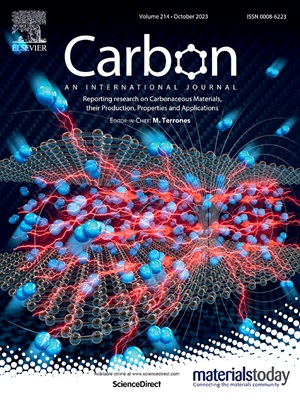噻唑修饰的石墨氮化碳触发n→π *电子跃迁增强光催化过氧化氢生成和罗丹明B降解
IF 10.5
2区 材料科学
Q1 CHEMISTRY, PHYSICAL
引用次数: 0
摘要
石墨氮化碳(g-C3N4, GCN)催化剂广泛应用于光催化氧还原生产过氧化氢(H2O2)和光催化降解污染物。但其光催化活性受到光响应范围窄、光电电荷分离转移效率低等限制。本文以苯并噻唑-2-羧醛(2-BTCA)和CN为原料,采用希夫碱缩合反应制备了噻唑修饰的g-C3N4。结果表明,噻唑结构接枝能有效改变氮化碳原有的对称结构,从而引发n→π *电子跃迁,增强光吸收能力,提高载流子迁移速率。利用这些优点,噻唑修饰的g-C3N4 (SCN-5)在90 min内的H2O2产率可达513.2 μmol L−1,是纯g-C3N4的2.2倍左右。因此,噻唑环修饰的g-C3N4可以有效地降解染料污染物,例如在60分钟内去除高达96.0%的罗丹明B (RhB),明显高于纯g-C3N4(66.2%)。密度泛函理论(DFT)计算和实验结果表明,噻唑环的引入提高了对O2和RhB分子的吸附能力。这促进了•O2−的生成,增强了RhB分子的活化和降解,从而提高了光催化性能。本研究为提高氧活性提供了一种有效的新策略,为双功能光催化剂的实际应用提供了一种直接的方法。本文章由计算机程序翻译,如有差异,请以英文原文为准。

Triggering n→π∗ electronic transitions by thiazole modified graphitic carbon nitride for enhanced photocatalytic hydrogen peroxide production and Rhodamine B degradation
Graphitic carbon nitride (g-C3N4, GCN) catalyst is widely used in photocatalytic oxygen reduction for hydrogen peroxide (H2O2) production and photocatalytic degradation of pollutants. However, its photocatalytic activity is restricted by its narrow light response range and low efficiency of photogenerated charge disjunction and transfer. In this work, thiazole modified g-C3N4 is prepared by Schiff-base condensation reaction of benzothiazole-2-carboxaldehyde (2-BTCA) and CN. It was found that grafting thiazole structures onto the conjugated polymer effectively alter the original symmetrical structure of carbon nitride, thereby triggering n→π∗ electronic transitions, intensifying light absorption capability, and increasing the charge carrier migration rate. Benefiting from these advantages, the H2O2 yield catalyzed by thiazole modified g-C3N4 (SCN-5) reaches up to 513.2 μmol L−1 within 90 min, which is about 2.2 times that of pure g-C3N4. Because of this, thiazole ring modified g-C3N4 can be efficiently degrade dye pollutants, for instance remove within 60 min up to 96.0 % of Rhodamine B (RhB), which is remarkably greater than that obtained with pure g-C3N4 (66.2 %). Both density functional theory (DFT) calculations and experimental results demonstrate that the introduction of thiazole rings improves adsorption capacity for O2 and RhB molecules. This facilitates the production of •O2− and enhances the activation and degradation of RhB molecules, thereby boosting photocatalytic performance. This research provides an effective new strategy for improving oxygen activation and offers a straightforward method for practical application of bifunctional photocatalysts.
求助全文
通过发布文献求助,成功后即可免费获取论文全文。
去求助
来源期刊

Carbon
工程技术-材料科学:综合
CiteScore
20.80
自引率
7.30%
发文量
0
审稿时长
23 days
期刊介绍:
The journal Carbon is an international multidisciplinary forum for communicating scientific advances in the field of carbon materials. It reports new findings related to the formation, structure, properties, behaviors, and technological applications of carbons. Carbons are a broad class of ordered or disordered solid phases composed primarily of elemental carbon, including but not limited to carbon black, carbon fibers and filaments, carbon nanotubes, diamond and diamond-like carbon, fullerenes, glassy carbon, graphite, graphene, graphene-oxide, porous carbons, pyrolytic carbon, and other sp2 and non-sp2 hybridized carbon systems. Carbon is the companion title to the open access journal Carbon Trends. Relevant application areas for carbon materials include biology and medicine, catalysis, electronic, optoelectronic, spintronic, high-frequency, and photonic devices, energy storage and conversion systems, environmental applications and water treatment, smart materials and systems, and structural and thermal applications.
 求助内容:
求助内容: 应助结果提醒方式:
应助结果提醒方式:


